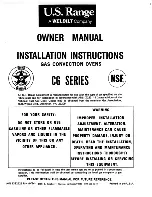
GB-24
TIPS AND ADVICE
ADDITION OF WATER
Vegetables and other foods with a high water
content can be cooked in their own juice or with the
addition of a little water. This ensures that many
vitamins and minerals are preserved.
FOOD IN SKINS OR SHELLS
Foods such as sausages, chickens, chicken legs,
baked potatoes, tomatoes, apples, egg yolks or such
like should be pricked or pierced with a fork or small
wooden skewer. This will enable the steam which
forms to dissipate without splitting the skin or shell.
FATTY FOODS
Fatty meat and layers of fat cook better than lean
portions of meat. Before cooking, cover the fatty
portions with a piece of aluminium foil or place the
food with the fat side down.
BLANCHING VEGETABLES
Before they are frozen vegetables should be
blanched. This is the best way of retaining the
quality and flavour. How to blanch vegetables:
Wash and chop the vegetable, place 250g of the
vegetable in a bowl with 275ml of water, cover
and heat for 3-5 minutes.
Plunge into cold water immediately after the
blanching process to prevent further cooking, and
then allow it to drain. Pack and freeze the
vegetable in airtight containers.
USING A FOOD THERMOMETER TO
DETERMINE COOKING TIME
Once cooked, every drink and every foodstuff has
a certain internal temperature at which the
cooking process can be switched off and the food
will be cooked. The internal temperature can be
ascertained with a food thermometer. The most
important temperatures are specified in the
temperature table.
TEMPERATURE TABLE
COOKING TIMES
All the times given in this cookery book are
guidelines, which can be varied according to the
initial temperature, weight and condition of the
food (water or fat content etc.).
SALT, SPICES AND HERBS
Food cooked in your microwave retains its
individual flavour better than it does when
conventional preparation methods are used. For
this reason you should use salt sparingly and
normally add it only after cooking. Salt absorbs
liquid and dries out the outer layer of food. Herbs
and spices can be used as normal.
TESTING THE FOOD
You can test whether food is cooked in the same
way as conventional cookery.
• Using a food thermometer. After cooking or re-
heating all foods have a certain internal
temperature. You can use a food thermometer to
test whether the food is hot enough, or ‘done’.
• Using a fork. Test fish with a fork. If the flesh is
not transparent and comes off the bone easily, it
is done. If it is overcooked, it will be brittle and
dry.
• Wooden skewer. Test cakes and bread by
sticking in a wooden skewer. If the skewer
comes out clean and dry, the food is ready.
Heating drinks
(Coffee, Water, Tea, etc.)
Heating milk
Heating soup
Heating stew
Poultry
Lamb
Pink
Well done
Roast beef
Rare
Medium
Well done
Pork, Veal
Drink / Food
Internal
Internal temp.
temperature
after 10 - 15 mins
once cooked
standing time
65-75o C
60-65o C
75-80o C
75-80o C
80-85o C
70o C
75-80o C
50-55o C
60-65o C
75-80o C
80-85o C
85-90o C
70-75o C
80-85o C
55-60o C
65-70o C
80-85o C
80-85o C
R-85ST-A_En Ckbk.qxd 7/2/07 2:42 PM Page 28
















































